Figure 3.
Frequencies of aCD11b+ monocytes and CD86hi naïve B cells distinguish SLE patients with early or late flare in random forest modeling. (a) Baseline frequencies of activated CD11b positive (aCD11b+) monocytes (top) and CD86high B cells (bottom) were quantified by flow cytometry in patients with early flare (n = 21) or late flare (n = 13) after steroid-induced disease suppression. For both comparisons, p < 0.05 by Mann-Whitney U test. (b) Random forest modeling with cellular, clinical, cytokine, and transcriptional panels identified late flare patients and three subgroups of early flare patients. The random forest model proximity matrix is shown as a multi-dimensionally reduced plot, where each point represents a patient, and the distance between two points represents dissimilarity between patients. (c) The variables included in the final random forest model for each independent panel (cellular, clinical, cytokine, and genetic module) are shown in a radial plot. Variables are grouped according to their involvement in the lymphoid, complement/cell adhesion, or myeloid system. Lines represent normalized values for the late flare group and the three early flare subgroups, as indicated.

